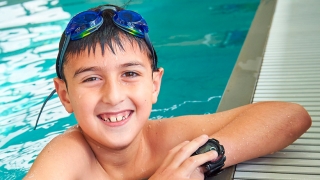Sneaky Summer Skin Infections You Can Pick Up at the Pool
Published on
Health Tip of the WeekPublished on
Health Tip of the Week We’re sure you’re wearing your sun protection and remembering to reapply — but did you know that sunburn is not the only threat to your skin in the warm weather months?
We’re sure you’re wearing your sun protection and remembering to reapply — but did you know that sunburn is not the only threat to your skin in the warm weather months?
One favorite summertime activity, swimming, presents some hidden hazards that can put your child at risk of developing a rash or skin infection. Experts in CHOP’s Dermatology Section share some things to watch out for to prevent some common summer skin infections.
Skinned knees are practically a badge of summer. While most people are careful to disinfect a new wound, the risk of infection remains even days later when open skin meets open water.
Bacteria, parasites or viruses lurking in lakes, ponds, the ocean or even insufficiently chlorinated pools or hot tubs can enter breaks in the skin and increase the risk of “swimming skin infections,” such as swimming pool granuloma, “swimmer’s itch,” “seabather’s eruption,” and pseudomonas dermatitis (sometimes called “hot tub rash”). These rashes typically appear as reddish bumps or pimples that may itch, burn or blister.
Until a scrape or cut heals, it’s best to avoid swimming anywhere but in a well-maintained pool.
Flip flops are the footwear of choice for dodging athlete’s foot infections in gym showers and locker rooms. But few people think of catching this highly contagious fungal infection once they’re inside the pool area.
The fungus that causes athlete’s foot is known to thrive in the perimeter of the pool area, too. Have your child wear flip flops on the pool deck whenever possible to avoid the cracked, itchy skin that can plague the skin between the toes, and remind your child to dry his feet after a swim. A moist environment encourages growth of the fungus, and dry feet can help prevent an infection.
When it’s time to dry off, kids often grab for the closest towel. But swimmers beware — towels can be another breeding ground for viruses and bacteria.
Impetigo, a bacterial infection that causes crusty sores or blisters, can be transmitted through towels. So can the viral infection molluscum contagiosum, which often appears as clusters of pink or flesh-colored bumps.
So be sure to have fresh clean towels on hand, and make sure your kids know to grab their own when they climb out of the pool.
Find more details and photos of common rashes and infections so you know what to look for. If you suspect your child has developed any of these conditions, be sure to consult your pediatrician, primary care physician, dermatologist or pediatric dermatologist. An antibiotic or another medicine may be necessary.
Contributed by: Albert C. Yan, MD, FAAP, FAAD
Categories: Health & Wellness, Parenting, Infectious Diseases, Health Tip of the Week
Are you looking for advice to keep your child healthy and happy? Do you have questions about common childhood illnesses and injuries? Subscribe to our Health Tips newsletter to receive health and wellness tips from the pediatric experts at Children's Hospital of Philadelphia, straight to your inbox. Read some recent tips.